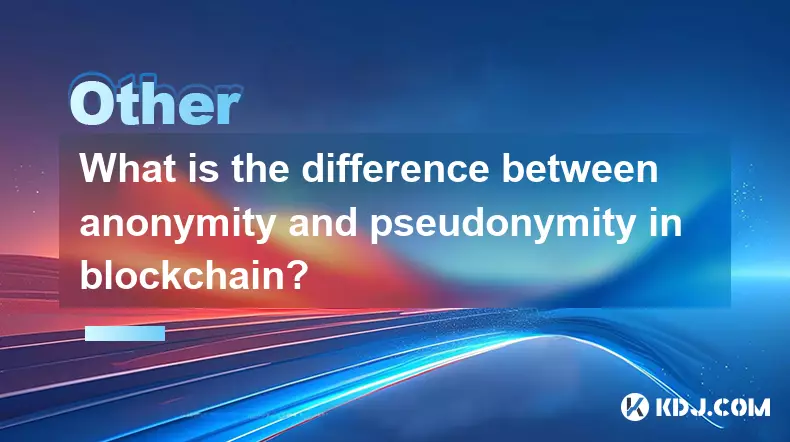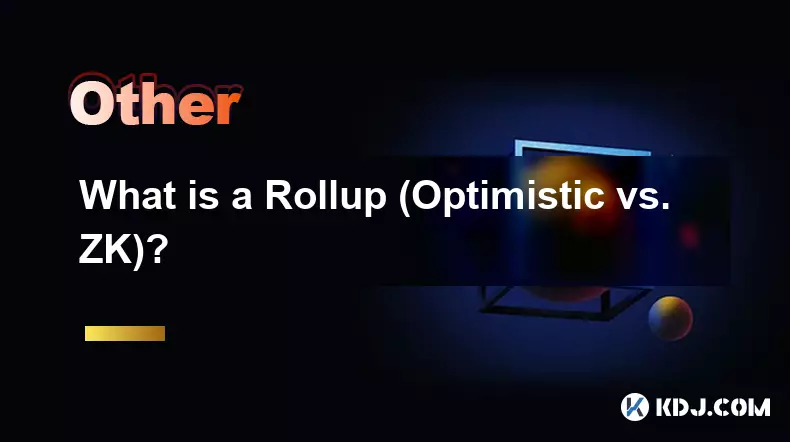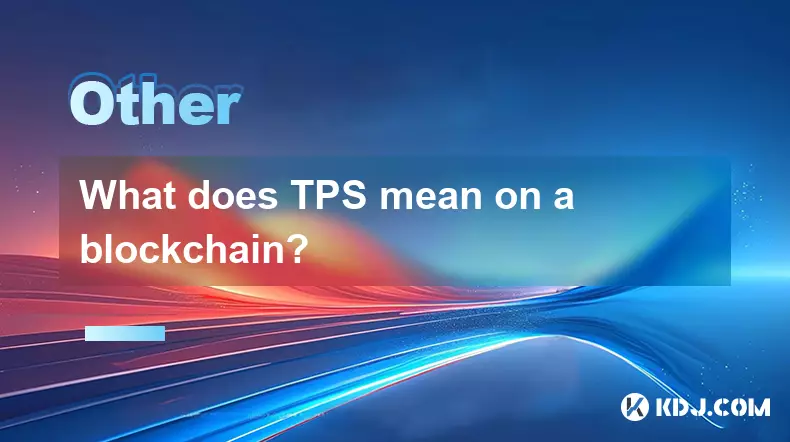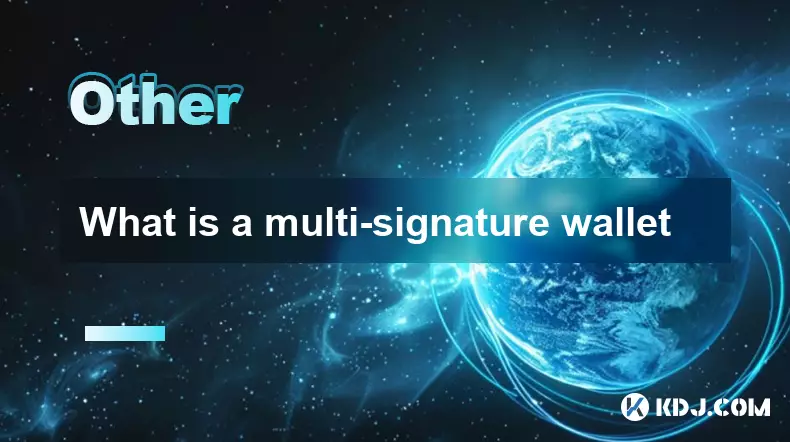-
 bitcoin
bitcoin $112195.049338 USD
2.42% -
 ethereum
ethereum $4124.915858 USD
2.81% -
 tether
tether $1.000570 USD
0.02% -
 xrp
xrp $2.861568 USD
2.25% -
 bnb
bnb $1000.346670 USD
3.04% -
 solana
solana $209.070819 USD
3.38% -
 usd-coin
usd-coin $0.999870 USD
0.02% -
 dogecoin
dogecoin $0.235379 USD
2.65% -
 tron
tron $0.335681 USD
-0.20% -
 cardano
cardano $0.803501 USD
3.38% -
 hyperliquid
hyperliquid $47.120881 USD
3.56% -
 chainlink
chainlink $21.501300 USD
3.44% -
 ethena-usde
ethena-usde $1.000571 USD
0.02% -
 avalanche
avalanche $29.793378 USD
3.62% -
 stellar
stellar $0.366964 USD
2.42%
What is the difference between anonymity and pseudonymity in blockchain?
Monero and Zcash use advanced cryptography to ensure true anonymity, making transaction details untraceable, unlike Bitcoin’s pseudonymous, traceable addresses.
Sep 02, 2025 at 08:18 pm

Understanding Anonymity in Blockchain Systems
1. Anonymity refers to the condition where a user's identity is entirely concealed during transactions. In a truly anonymous blockchain system, no personal information is linked to the transaction data, making it impossible to trace activities back to an individual.
2. Some blockchains are designed with advanced cryptographic techniques such as zero-knowledge proofs or ring signatures to ensure complete privacy. These mechanisms allow verification of transactions without revealing sender, receiver, or amount.
3. Examples include privacy-focused cryptocurrencies like Monero and Zcash, which implement protocols specifically to obscure transaction details and prevent external analysis.
4. The goal of anonymity is to provide maximum privacy, shielding users from surveillance, tracking, or profiling by third parties including governments, corporations, or malicious actors.
5. However, full anonymity raises concerns related to regulatory compliance, money laundering, and illicit activities, leading to increased scrutiny from financial authorities worldwide.
The Nature of Pseudonymity in Public Blockchains
1. Pseudonymity means that users operate under persistent identifiers—typically wallet addresses—instead of real-world identities. These addresses appear as random strings of characters on the blockchain ledger.
2. While the actual name or personal details of a user aren't stored on-chain, repeated use of the same address can allow behavioral analysis and linkage of transactions over time.
3. Bitcoin is a prime example of a pseudonymous system; all transactions are publicly recorded, and if an address is ever linked to a real identity, the entire transaction history becomes traceable.
4. Chain analysis firms leverage data clustering, input-output patterns, and metadata to de-anonymize users, effectively reducing the privacy promised by pseudonymity.
5. Exchanges that require KYC (Know Your Customer) procedures further weaken pseudonymity, as they create bridges between digital identities and government-issued IDs.
Key Differences in Practical Applications
1. Anonymity ensures that even with full access to the blockchain data, no entity can determine who sent or received funds, while pseudonymity only hides direct identity but allows traceability through address patterns.
2. In anonymous networks, transaction graph analysis fails due to obfuscation layers, whereas in pseudonymous systems, forensic tools can often reconstruct user behavior and map financial relationships.
3. Regulatory bodies tend to oppose fully anonymous blockchains, citing anti-money laundering (AML) requirements, while pseudonymous systems are more widely accepted due to their auditability.
4. Developers building decentralized applications must consider these models when designing for privacy, compliance, or user trust, as choosing between anonymity and pseudonymity impacts both functionality and legal risk.
5. Users seeking privacy may combine pseudonymous blockchains with mixers or coinjoin techniques to enhance obfuscation, though these methods are not foolproof and may attract regulatory attention.
Frequently Asked Questions
Can a pseudonymous blockchain become anonymous?Not inherently. Pseudonymous blockchains record transparent transaction histories. While additional tools like mixers or privacy wallets can improve privacy, they don't transform the underlying protocol into an anonymous one.
Are anonymous blockchains illegal?No, they are not universally illegal. However, several jurisdictions have restricted or banned privacy coins due to concerns over criminal misuse. Legality depends on local regulations and enforcement policies.
How do exchanges affect blockchain privacy?Exchanges often require identity verification, which links wallet addresses to real individuals. This connection undermines both pseudonymity and anonymity when funds move between private wallets and centralized platforms.
Is it possible to track transactions on Monero?Due to its use of ring signatures, stealth addresses, and confidential transactions, tracking sender, receiver, or amount on Monero's blockchain is computationally infeasible for external observers.
Disclaimer:info@kdj.com
The information provided is not trading advice. kdj.com does not assume any responsibility for any investments made based on the information provided in this article. Cryptocurrencies are highly volatile and it is highly recommended that you invest with caution after thorough research!
If you believe that the content used on this website infringes your copyright, please contact us immediately (info@kdj.com) and we will delete it promptly.
- Ethereum's Price Dance: Will Crypto Rallies Keep the Music Playing?
- 2025-09-29 08:25:12
- Crypto Staking Spotlight: BlockDAG's Referral Revolution Outshines Avalanche & Meme Coin Hype
- 2025-09-29 08:45:16
- BlockDAG, SUI, Chainlink: Navigating the Crypto Landscape in 2025
- 2025-09-29 08:25:12
- XRP Price Gears Up: Breakout Signals and What to Watch
- 2025-09-29 08:30:01
- Bitcoin, Gold, and Digital Assets: Navigating the New Financial Frontier
- 2025-09-29 08:45:16
- UN Embraces Blockchain: A Pension Fund Success Story and a Glimpse into the Future
- 2025-09-29 08:50:01
Related knowledge

What is a token economy?
Sep 20,2025 at 12:18am
Understanding the Foundations of a Token Economy1. A token economy in the context of cryptocurrency refers to a system where digital tokens are used a...

What are suitable application scenarios for blockchain?
Sep 20,2025 at 03:19am
Decentralized Finance (DeFi) Platforms1. Blockchain enables the creation of financial services without centralized intermediaries, allowing users to l...

What is a Rollup (Optimistic vs. ZK)?
Sep 22,2025 at 03:00pm
Understanding Rollups in Blockchain Technology1. Rollups are layer-2 scaling solutions designed to increase transaction throughput on blockchains like...

What is blockchain scalability?
Sep 19,2025 at 06:18am
Understanding Blockchain Scalability1. Blockchain scalability refers to a network's ability to handle an increasing number of transactions without com...

What does TPS mean on a blockchain?
Sep 21,2025 at 09:54am
Understanding TPS in Blockchain Technology1. TPS stands for Transactions Per Second, a metric used to measure the number of transactions a blockchain ...

What is a multi-signature wallet
Sep 20,2025 at 07:00am
Understanding Multi-Signature Wallets in Cryptocurrency1. A multi-signature wallet, often referred to as a multisig wallet, is a type of cryptocurrenc...

What is a token economy?
Sep 20,2025 at 12:18am
Understanding the Foundations of a Token Economy1. A token economy in the context of cryptocurrency refers to a system where digital tokens are used a...

What are suitable application scenarios for blockchain?
Sep 20,2025 at 03:19am
Decentralized Finance (DeFi) Platforms1. Blockchain enables the creation of financial services without centralized intermediaries, allowing users to l...

What is a Rollup (Optimistic vs. ZK)?
Sep 22,2025 at 03:00pm
Understanding Rollups in Blockchain Technology1. Rollups are layer-2 scaling solutions designed to increase transaction throughput on blockchains like...

What is blockchain scalability?
Sep 19,2025 at 06:18am
Understanding Blockchain Scalability1. Blockchain scalability refers to a network's ability to handle an increasing number of transactions without com...

What does TPS mean on a blockchain?
Sep 21,2025 at 09:54am
Understanding TPS in Blockchain Technology1. TPS stands for Transactions Per Second, a metric used to measure the number of transactions a blockchain ...

What is a multi-signature wallet
Sep 20,2025 at 07:00am
Understanding Multi-Signature Wallets in Cryptocurrency1. A multi-signature wallet, often referred to as a multisig wallet, is a type of cryptocurrenc...
See all articles










































































